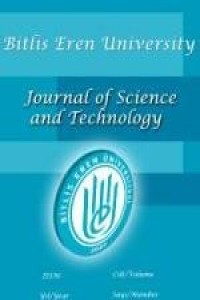Performance prediction of a single-stage refrigeration system using R134a as a refrigerant by artificial intelligence and machine learning method
Abstract
In this study, COP and heat capacities of evaporator and condenser were calculated by artificial intelligence and machine learning method in a vapor compression mechanical refrigeration cycle using well-known R134a as a refrigerant. Dataset was obtained with CoolPack software to train the model. Evaporating, condensing, superheating and subcooling temperatures are selected as input data. COP, heat capacities of evaporator and condenser are included in the dataset as target values. Artificial Neural Network (ANN) model was created with Matlab R2018b software and validated with target data. The output files obtained were compared with the target files and it was found that the mean square error value was quite close to one. The results of this study show that the ANN method can be used to obtain cycle parameters in one stage refrigeration cycle with high accuracy.
Keywords
Artificial neural networks Refrigeration cycle Artificial intelligence Machine learning Thermodynamics
References
- [1] N.E. Klepeis, W.C. Nelson, W.R. Ott, J.P. Robinson, A.M. Tsang, P. Switzer, J. V. Behar, S.C. Hern, W.H. Engelmann, The National Human Activity Pattern Survey (NHAPS): A resource for assessing exposure to environmental pollutants, J. Expo. Anal. Environ. Epidemiol. 11 (2001) 231–252. doi:10.1038/sj.jea.7500165.
- [2] T. Akimoto, S. ichi Tanabe, T. Yanai, M. Sasaki, Thermal comfort and productivity - Evaluation of workplace environment in a task conditioned office, Build. Environ. 45 (2010) 45–50. doi:10.1016/j.buildenv.2009.06.022.
- [3] S. ichi Tanabe, M. Haneda, N. Nishihara, Workplace productivity and individual thermal satisfaction, Build. Environ. 91 (2014) 42–50. doi:10.1016/j.buildenv.2015.02.032.
- [4] P. Wargocki, D.P. Wyon, j. Sundell, G. Clausen, P.O. Fanger, The Effects of Outdoor Air Supply Rate in an Office on Perceived Air Quality, Sick Building Syndrome (SBS) Symptoms and Productivity, Indoor Air. 10 (2000) 222–236. doi:10.1034/j.1600-0668.2000.010004222.x.
- [5] P. and C.E.U. European Commission Joint Research Centre, Institute For Health and Consumer Protection, Ventilation, good indoor air quality and rational use of energy, Rep. No. 23, EUR20741 EN. (2003).
- [6] B. Kılıç, Alternative Approach For Thermal Analysis Of Transcritical Co2 One-Stage Vapor Compression Cycles, Int. J. Eng. Appl. Sci. 8 (2016) 1–1. doi:10.24107/ijeas.251263.
- [7] M. Hosoz, H.M. Ertunc, Modelling of a cascade refrigeration system using artificial neural network, Int. J. Energy Res. (2006). doi:10.1002/er.1218.
- [8] Ö. Kizilkan, A.Ş. Encan, K. Yakut, R410a Soğutucu Akişkaninin Termodina Ik Özelliklerinin Yapay Sinir Ağlari Metoduyla Modellenmesİ, 21 (2006) 395–400.
- [9] S. Yilmaz, K. Atik, Modeling of a mechanical cooling system with variable cooling capacity by using artificial neural network, Appl. Therm. Eng. 27 (2007) 2308–2313. doi:10.1016/j.applthermaleng.2007.01.030.
- [10] R. Yamankaradeniz, İ. Horuz, Ö. Kaynakli, S. Coşkun, N. Yamankaradeniz, Soğutm tekniği ve Isı Pompası Uygulamaları, 3., DORA, Bursa, 2013.
- [11] S.A. Kalogirou, Artificial neural networks in renewable energy systems applications: A review, Renew. Sustain. Energy Rev. (2000). doi:10.1016/S1364-0321(01)00006-5.
- [12] H. Yağlı, A. Koç, A. Yapıcı, H.H. Bilgiç, Deneysel Bi̇r Organi̇k Ranki̇n Çevri̇mi̇nde YapaSi̇ni̇r Ağlari (Ysa) Yardimiyla Güç Tahmi̇ni̇, Selcuk Univ. J. Eng. ,Science Technol. 4 (2016) 7–7. doi:10.15317/scitech.2016116091.
Abstract
References
- [1] N.E. Klepeis, W.C. Nelson, W.R. Ott, J.P. Robinson, A.M. Tsang, P. Switzer, J. V. Behar, S.C. Hern, W.H. Engelmann, The National Human Activity Pattern Survey (NHAPS): A resource for assessing exposure to environmental pollutants, J. Expo. Anal. Environ. Epidemiol. 11 (2001) 231–252. doi:10.1038/sj.jea.7500165.
- [2] T. Akimoto, S. ichi Tanabe, T. Yanai, M. Sasaki, Thermal comfort and productivity - Evaluation of workplace environment in a task conditioned office, Build. Environ. 45 (2010) 45–50. doi:10.1016/j.buildenv.2009.06.022.
- [3] S. ichi Tanabe, M. Haneda, N. Nishihara, Workplace productivity and individual thermal satisfaction, Build. Environ. 91 (2014) 42–50. doi:10.1016/j.buildenv.2015.02.032.
- [4] P. Wargocki, D.P. Wyon, j. Sundell, G. Clausen, P.O. Fanger, The Effects of Outdoor Air Supply Rate in an Office on Perceived Air Quality, Sick Building Syndrome (SBS) Symptoms and Productivity, Indoor Air. 10 (2000) 222–236. doi:10.1034/j.1600-0668.2000.010004222.x.
- [5] P. and C.E.U. European Commission Joint Research Centre, Institute For Health and Consumer Protection, Ventilation, good indoor air quality and rational use of energy, Rep. No. 23, EUR20741 EN. (2003).
- [6] B. Kılıç, Alternative Approach For Thermal Analysis Of Transcritical Co2 One-Stage Vapor Compression Cycles, Int. J. Eng. Appl. Sci. 8 (2016) 1–1. doi:10.24107/ijeas.251263.
- [7] M. Hosoz, H.M. Ertunc, Modelling of a cascade refrigeration system using artificial neural network, Int. J. Energy Res. (2006). doi:10.1002/er.1218.
- [8] Ö. Kizilkan, A.Ş. Encan, K. Yakut, R410a Soğutucu Akişkaninin Termodina Ik Özelliklerinin Yapay Sinir Ağlari Metoduyla Modellenmesİ, 21 (2006) 395–400.
- [9] S. Yilmaz, K. Atik, Modeling of a mechanical cooling system with variable cooling capacity by using artificial neural network, Appl. Therm. Eng. 27 (2007) 2308–2313. doi:10.1016/j.applthermaleng.2007.01.030.
- [10] R. Yamankaradeniz, İ. Horuz, Ö. Kaynakli, S. Coşkun, N. Yamankaradeniz, Soğutm tekniği ve Isı Pompası Uygulamaları, 3., DORA, Bursa, 2013.
- [11] S.A. Kalogirou, Artificial neural networks in renewable energy systems applications: A review, Renew. Sustain. Energy Rev. (2000). doi:10.1016/S1364-0321(01)00006-5.
- [12] H. Yağlı, A. Koç, A. Yapıcı, H.H. Bilgiç, Deneysel Bi̇r Organi̇k Ranki̇n Çevri̇mi̇nde YapaSi̇ni̇r Ağlari (Ysa) Yardimiyla Güç Tahmi̇ni̇, Selcuk Univ. J. Eng. ,Science Technol. 4 (2016) 7–7. doi:10.15317/scitech.2016116091.
Details
| Primary Language | English |
|---|---|
| Journal Section | Articles |
| Authors | |
| Publication Date | December 28, 2020 |
| Submission Date | December 25, 2020 |
| Published in Issue | Year 2020 Volume: 10 Issue: 2 |


